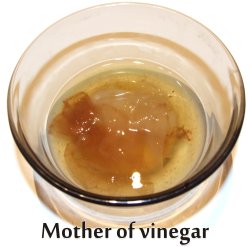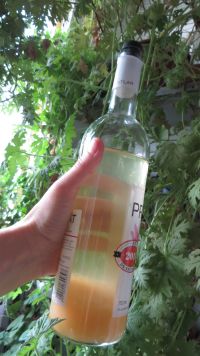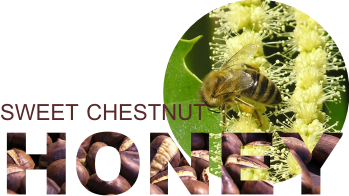What is honey vinegar?
It’s vinegar, acetic acid, just like regular vinegar, only that is made of honey. It’s not a common type of vinegar, mostly commercially available honey vinegars are produced in Italy, France, Romania and Spain.
How is honey vinegar made?
After learning how to make mead, it’s going to be piece of cake to make vinegar. Only remember that you can only make a good vinegar only if you have a good mead. Though, to be completely honest, making honey vinegar is not exactly justified. It takes time and we can find it in specialized shops if we need it. But it makes a nice challenge for a brewing or a DIY type of person.
If you are a beekeeper it’s a pity not to make mead and vinegar. Besides the taste, they are both very healthy.
A vinegar has to go through 3 steps till it gets vinegar: fermentation, inoculation with acetobacter and oxygen exposure. Summer is therefore by far the best time for vinegar making (over 70 deg. Fah). Basically we are first making mead!
Step1: Fermentation:
First make an unfermented mead, up of about 12 % potential alcohol (specific gravity @ 1.090) like this: use 2.5 pounds of honey plus water to make a gallon of solution. Then let it ferment in a sanitized two-gallon vessel with an airlock for a month or two, at room temperature, until there are absolutely no bubbles.
Step 2: Inoculation with acetobacter:
This can be done in 2 ways:
• First, leave the mead on your patio, on a warm day, uncovered, for a few hours, allowing fruit flies and other insects to dab their nasty bacteria-laden feet into it, inoculating it with acetobacter (Acetic acid bacteria).
• Or, the second way: use a “mother of vinegar” from an unpasteurized bottle of quality vinegar you can find in a store, or in a specialized homebrew shop, or on Amazon. They’re basically a pellicle, the structure of a mature colony of vinegarmaking organism, that slowly eats alcohol in the presence of oxygen and makes acetic acid out of it (vinegar).
Step 3. Oxygen exposure
Mother of vinegar turns the alcohol formed in our mead into acetic acid, with the help of oxygen from the air. For this, let the mead in a jug, or other vessel covered with cheesecloth to allow oxygen exchange, but which will keep insects out.

The color will at first be quite light, but in course of time it will assume an amber shade and gradually darken with age. If you want a darker color sooner, than the vinegar should be bottled in light glass bottles, and exposed to the light.
The final vinegar production process takes between 18 months and 2 years for a single batch of vinegar.
One producer says he turns 10-11 lbs of honey into 5 gallons of vinegar approximately 50- 375 ml bottles of vinegar which can be sold at a cost of $250. This is is far better than retailing your honey. How about that!
If you want to know more about producing vinegar, here is a pdf copy of a book written in 1935, “Honey Vinegar”, by Frederick W. Fabian. It’s detailed and full of info for those who want to make vinegar the old-fashion organic way.
Any health benefits of honey vinegar?
Here are some specific benefits of honey vinegar:
- Enhances digestion
- Nourishes and rejuvenates the skin
- Helps to lose weight
- Prevents apathy, hay fever, sore throat, stomach discomfort
- Promotes blood circulation
- Honey and honey vinegar in equal quantities, taken a teaspoonful at a time, is an excellent remedy for sore throat and cough.
 Benefits of all types of vinegar: (if they are natural, with good bacteria (mother of vinegar) in them. When buying a bottle of vinegar you should see them at the bottom. Otherwise the commercial vinegar has been too well filtrated and pasteurized, and besides taste, there are no other good benefits for our health. Not to mention that large quantities of vinegar sold in our superstores, have injurious adulterants and impurities. Many samples, upon analysis, have been found to include a considerable percentage of sulphuric acid, or nitric acid, added either as a preservative or to increase the acidity. Others have contained, as the results of carelessness in manufacture, such poisonous ingredients as copper, arsenic, and lead.).
Benefits of all types of vinegar: (if they are natural, with good bacteria (mother of vinegar) in them. When buying a bottle of vinegar you should see them at the bottom. Otherwise the commercial vinegar has been too well filtrated and pasteurized, and besides taste, there are no other good benefits for our health. Not to mention that large quantities of vinegar sold in our superstores, have injurious adulterants and impurities. Many samples, upon analysis, have been found to include a considerable percentage of sulphuric acid, or nitric acid, added either as a preservative or to increase the acidity. Others have contained, as the results of carelessness in manufacture, such poisonous ingredients as copper, arsenic, and lead.).
- Vinegar is anti-scorbutic and anti-bilious.
- Largely diluted it forms a very refreshing beverage. It had beneficial results in past ages and it is still used in modern times, by soldiers on long marches, or by other people engaged in hard, exhausting labor.
- Very useful in hoarseness – if we inhale vapors of vinegar
- Helps a lot in throat conditions, if gargled in a diluted form.
- It’s an aid to digestion. If taken in moderation.
!As a rule, pure vinegar should not be taken in large quantities.
Vinegar was used as medicine ever since the Old Testament. There are some allusions there that tell us Hebrews were using it. It also appears in the New Testament. And in the writings of classical writers like Pliny, Livy, and others, so, the Romans and Greeks were using it, too.
These daysm vinegar is used for culinary and preservative purposes, but it is still largely used medicinally.
Other types of vinegar
The most popular these days is Cider Vinegar. An unfiltered cider vinegar is made from unfiltered organic cider. If you believe that drinking vinegar is good for your health, this is your product. It is a popular choice for dressings for fruit and vegetable salads, marinades, and for making chutneys.
Wine Vinegars, mostly made from red and white. Red wine vinegars tend to have more roundness of flavor, but white wine vinegars are better suited for lighter colored sauces and other dishes where the red color would be intrusive. White wine vinegar is a staple of French cuisine, for hollandaise and béarnaise sauces, fish marinades and for deglazing.
Rice Wine Vinegar (White, Black and Red) is generally milder than other vinegars. It is made from fermented rice or fermented rice wine and it’s popular especially in China and Japan.
Sherry Vinegar is made like sherry from a blend of different wines, authentic sherry vinegar is made in Spain, using the solera style of aging, fermented for years in a series of increasingly smaller oak barrels.
Champagne Vinegar is made from the grapes of the Champagne region of France (the grapes are Chardonnay and/or Pinot Noir).
Vinegar made from beer is produced in the United Kingdom, Germany, Austria, and the Netherlands.
Malt Vinegar is made from sprouted barley, like an unhopped beer solution and aged before being bottled.
Balsamic Vinegar is made of grape juice that has been boiled down and concentrated, rather than wine. It originates in Italy, the tradition of balsamic vinegar-making in Modena, has not changed in 600 years. Trebbiano grapes are boiled down to a near-syrup and go through multiple fermentations and lengthy maturation periods. All authentic balsamics are made in the cities of Modena and Reggio. A 40 year old balsamic vinegar can be $500.
This vinegar is not to be confused to nowadays balsamic vinegars with condiments, called condimento, or salsa grade. There are 20 to 100 condimento balsamics on the market.
Fruit, Herb & Spice Vinegars are made from fruits like raspberry, maple, plum etc and the herbs used can be: tarragon, herbs de Provence etc. The spices are often ginger, garlic, vanilla etc. These speciality flavored vinegars are made by adding these elements to either wine or cider vinegars. The bottled mixture is allowed to stand for some time before it is released, so all the flavors can blend.
There are:
– Kiwifruit vinegar,
– Plum vinegar,
– Vinegar made from raisins (called khall ʻinab in Arabic: grape vinegar, used in cuisines of the Middle East),
– Herb vinegars (flavored with herbs, most commonly Mediterranean herbs),
– Sweetened vinegar is of Cantonese origin, made from rice wine, sugar and herbs, including ginger, cloves, and other spices,
– Cane Vinegars, made of sugarcane juice, used in pickling, mustard-making and in vinaigrettes. Most popular in the Philippines
– Coconut vinegar, made from fermented coconut water, used extensively in Southeast Asian cuisine, especially in the Philippines and Sri Lanka,
– Sinamak vinegar, a Philippines spiced version that mixes the cane vinegar with siling labuyo, onions, and garlic,
– Chinese black vinegar is an aged product made from rice, wheat, millet, sorghum, or a combination. It has an inky black color and a complex, malty flavor.
– Job’s tears from Japan, an aged vinegar. Job’s tears is a tall, grain-bearing, tropical plant. The vinegar is similar in flavor to rice vinegar.
– Kombucha vinegar is made from kombucha, a symbiotic culture of yeast and bacteria. The bacteria produce a complex array of nutrients and populate the vinegar with bacteria that some claim promote a healthy digestive tract. Kombucha vinegar primarily is used to make a vinaigrette and is flavored by adding strawberries, blackberries, mint, or blueberries at the beginning of fermentation.
Related articles:
• What is mead?
• How to make mead at home!
• Mead recipes
• Types of mead
Picture sources:
Honey vinegar bottle from the featured picture source: euyansang.com.sg
“Essigmutter 01” by I, Zinnmann. Licensed under CC BY-SA 3.0 via Wikimedia Commons
===============
===============
References:
gutenberg.org;
formerlynmurbanhomesteader.weebly.com;
www.amazon.com/forum




Do you have any salad dressing recipes using honey vinegar?
I love your site! You have built a composite of brilliance offering fun, practical and hopeful information that examines bees, people and the planet. Thank you so much!